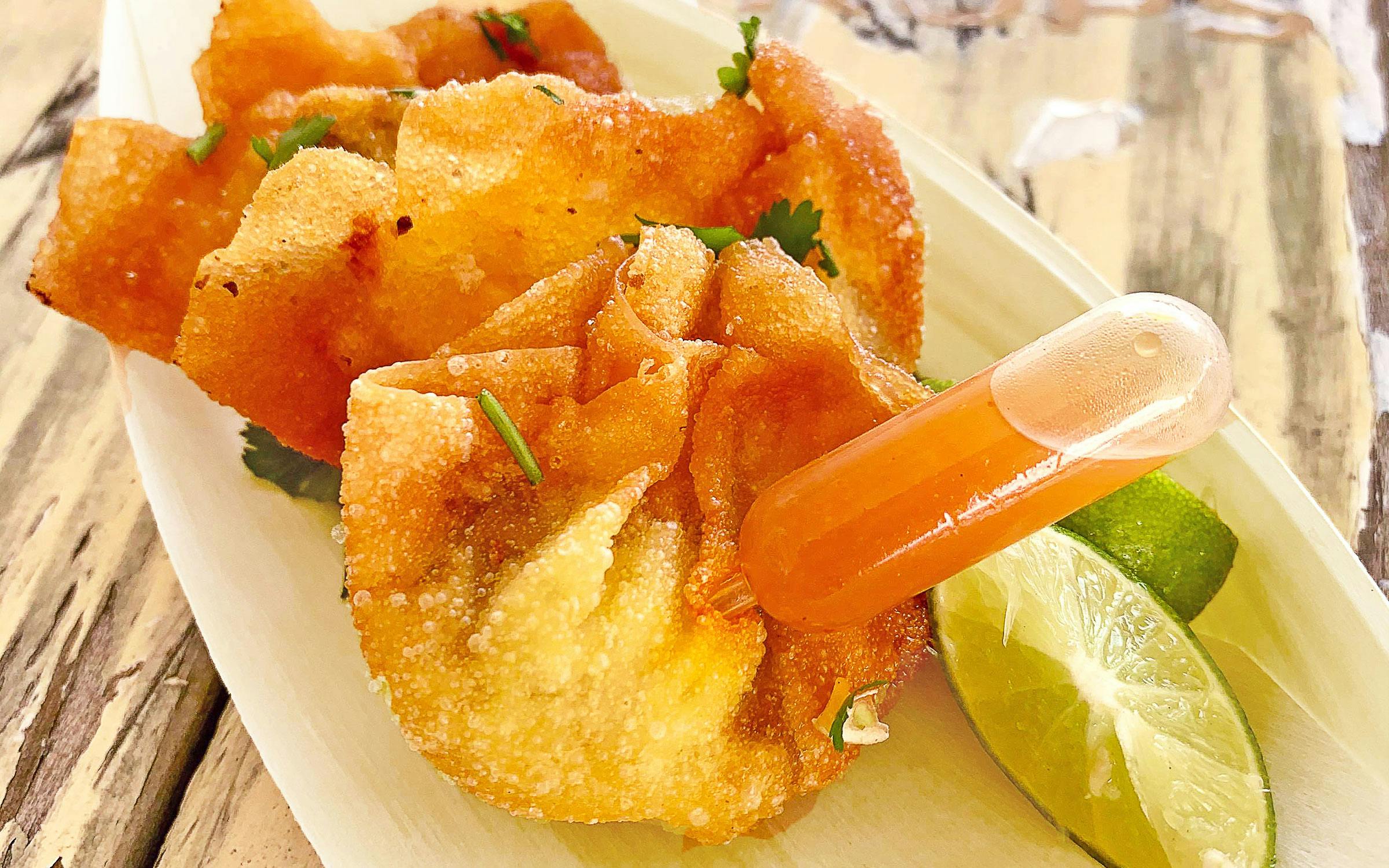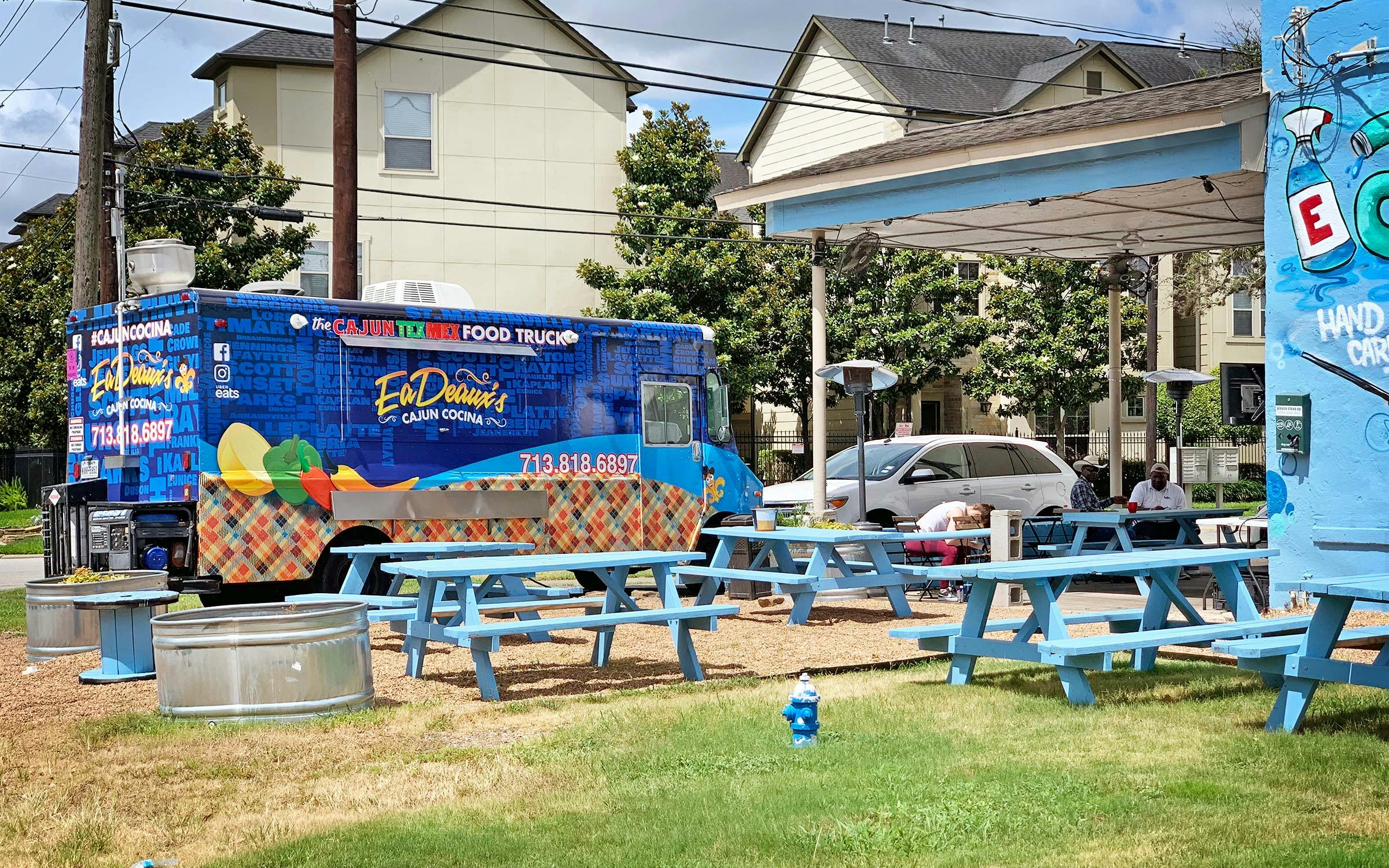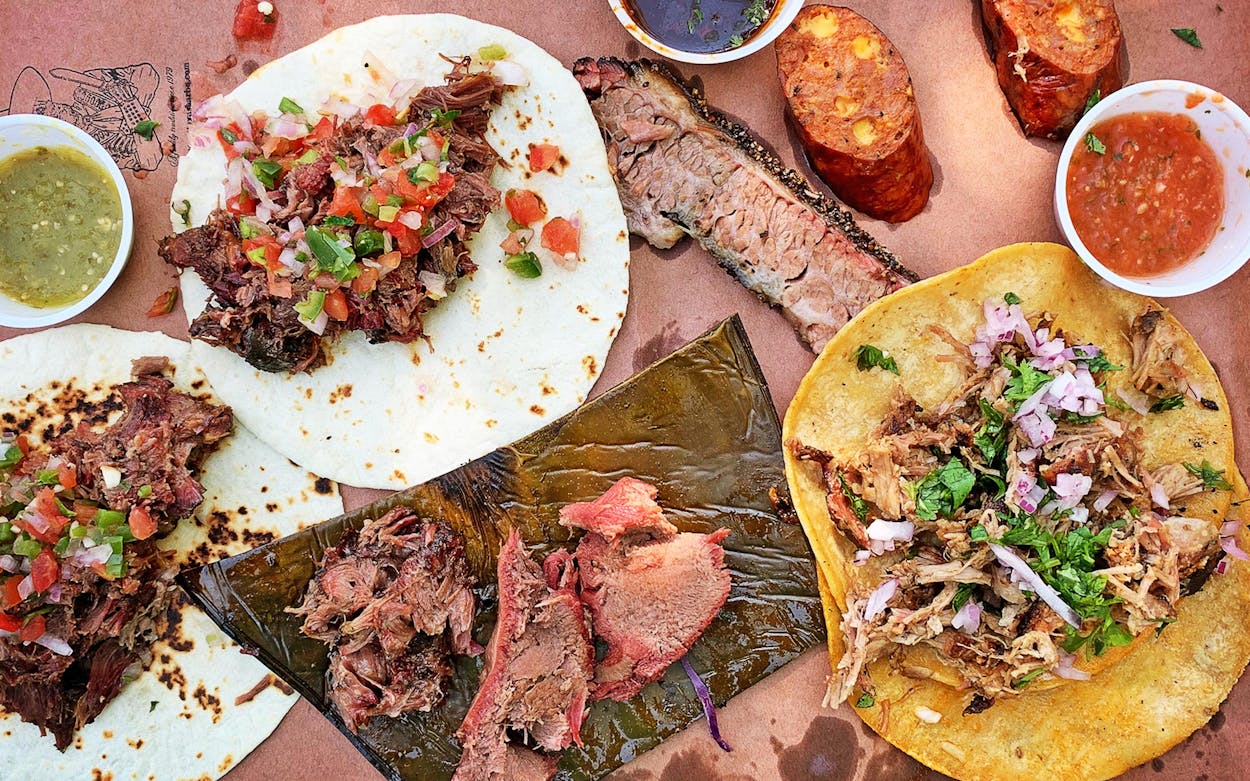Three years ago, Frank Hernandez opened the King Kups trailer at a McKinney gas station. He originally planned to dish out only elotes, cups of cooked corn kernels doused in cream, butter, queso fresco, hot sauce, and other toppings. “We would come up with different versions of elotes, doing the Flamin’ Hot Cheetos and different flavors. It just grew from there,” Hernandez tells me. A stocky, goateed former nightclub DJ and promoter, the McKinney native decided to go into the food business after years of traveling to California to visit friends and peers in the music industry. They would trade barbs about the differences in Mexican food between their home states. At first, Hernandez wanted to bridge Texas Mexican and Cali-Mex with a laser focus on elotes. But a year after opening King Kups, he met Jen Hui, a Chinese immigrant and entrepreneur looking to invest in a food truck. After becoming business partners, Hernandez and Hui expanded the truck’s offerings to include carne asada fries, burritos, and a variety of tacos.
A taco de birria de res (in this case, a stew made with beef shoulder) was a recent addition to the menu. That shouldn’t be a surprise, as birria continues to be the hottest taco trend to hit Texas in years. But in early December, King Kups started serving something special: birria wontons. I came across the dish on Instagram, where a local taco aficionado posted a preview. I was surprised, and knew I needed to try them and talk with the cook about this new creation.
Hernandez said the concept for the birria wontons came from an informal brainstorming session. “Jen and I were sitting in the truck,” he says. “We were kicking around ideas, tasting the birria and the consommé together. Then we got around to talking about different ways that we can apply it to the menu.” Hui brought in wonton wrappers. Hernandez filled them with birria and fried them. Happy with the results, the business partners began offering orders of five pouches of light dough filled with the same stewed beef and cheddar-quesillo mixture that packs the birria tacos. The wontons come with plastic injectors filled with consommé, and the customer shoots the liquid into the fried purses, making for a one-of-a-kind experience. A crispy, slightly sweet wrapper gives way to silky strands of meat slick with juices. A paper sack of these on the couch would make for a great movie night.
King Kups’s intertwining of Chinese and Mexican food is a model for the hybridization that is the hallmark of contemporary Texas food. I call it culinary cultural appreciation, in contrast to what is often referred to as “cultural appropriation.” That term is often deployed, in the context of food, when a person or business exploits the cuisine of a minority or marginalized community, in a way that members of that community find objectionable. Cultural appreciation, on the other hand, involves knowledge of, and respect for, a food’s history and flavor profile. Hernandez and Hui’s birria wontons offer an excellent example of cultural appreciation.

Here in Texas, where tacos are an essential part of the state’s culinary identity—and where everything eventually ends up in a tortilla—innovation has come through the collaborative efforts of Mexican Americans, South Asians, and members of many other cultural and ethnic groups. Tracking these innovations is central to my coverage of the state’s Mexican food. Texas is vast and so is its Mexican cuisine, which includes everything from chili and chile con queso to barbecue and unique tacos. Mexican food, wherever it is made and served, reflects its time and place. It’s regional, sometimes hyper-regional, and dependent on dynamic variables. It thrives in tinkering. It’s how tacos de trompo were born. (I lay out this and other culinary changes in my Ultimate Texas Tacopedia, a deep-dive compendium of the state’s taco diversity.) My sampling of thousands of tacos has revealed that, at least in Texas, cultural appreciation—the respectful, careful, knowledgeable exchange of ingredients and ideas to embody something new—is supplanting cultural appropriation.
One example of this (and another part of the Tacopedia) is found in Houston, where husband-and-wife team Jason and Starr Harry opened Eadeaux’s Cajun Cocina at their car wash in the rapidly developing EaDo neighborhood. Jason, a Louisiana Cajun, and Starr, from Phoenix, who are both Black, thoughtfully considered their location between the Third Ward, an African American neighborhood, and the Second Ward, which is majority Mexican American. Eadeaux’s would be a bridge between the enclaves, the Harrys decided. “I felt like we were right in the middle of a lot of things. I thought, let’s do some tacos,” Jason told me before the pandemic. A hybridization of the couple’s multicultural backgrounds in the Southwest and the Cajun country, their tacos are filled with gumbo and étouffée, rich, spicy, home-style dishes not far from the stews that comprise tacos de guisados.
Also in Houston, celebrated chef Hugo Ortega has taken this kind of adaptability to another level at modern Mexican restaurants Hugo’s and Xochi. Five years ago, the chef, who grew up outside of Oaxaca, received a fig tree cutting. As an experiment, he planted it in Hugo’s parking lot, and when it fruited, he made a mole from the harvest, being careful to use chiles that wouldn’t overpower the figs. The ancho and mulato smoothed out the sweetness like a gentle iron over wrinkled linens. Ortega served the mole with quail he shot on a hunt with friends. “It’s about seeing what is local and the abundance of the ingredients,” he says. “I apply what I know with the ingredients I can get.” This kind of thoughtful experimentation can move a cuisine forward. It’s a natural progression.
Not so natural are corporate taco chains where Nashville hot tofu is wrapped in a stiff flour tortilla, foie gras is drowned in poutine, and a chicken-and-waffle taco is a sloppy assembly of chicken strips and dressings in a “waffle” tortilla. These are not tacos; these are stunts. The missing ingredient? Respect for traditions.
As the restaurant industry suffers through the pandemic without needed financial help, cooks, chefs, and pitmasters are adapting. Tacos in Texas are a surefire hit. Cram braised beef into a mass-produced tortilla and call it barbacoa, smoked birria, or smoked suadero—whatever you’d like—and people can’t wait to line up. That’s fine. It’s a business decision, but it’s one that might not be made with self-awareness or an understanding of the food and its traditions. You can’t simply smoke and braise brisket and call it suadero. The traditional taco preparation commonly acknowledged to come from Mexico City is a specific cut toward the back of the cow. In the U.S., brisket stands in for the classic suadero. To be recognized as suadero, however, the beef must be braised in lard and then finished on a flattop, giving the preparation a silky-crispy texture. I’ve also seen pitmasters inaccurately refer to confit brisket as barbacoa. All of this mislabeling, whether on purpose or not, can lead to confusion.

Houston-based cookbook author and filmmaker Adán Medrano explores the fight to hold on to food traditions in his award-winning new documentary, Truly Texas Mexican—Cuisine and Culture: A New Encounter. “It also has a historical connection with memory and your sense of being, as land does.” And few regional foods are more tied to the land than Mexican cuisine. Specific dishes are even prepared in the land, including barbacoa. Arnulfo “Trey” Sanchez, owner-pitmaster of Vaqueros Texas Bar-B-Q, in Grapevine, prepares traditional Tejano barbacoa de cabeza (beef head barbacoa) in his smoker. With Sanchez’s wrapping of whole heads in pencas de maguey (agave leaves) and his low-and-slow smoking, the Tejano pitmaster could properly call his dish barbacoa. However, Sanchez refuses to do so because he’s not using a pozo (an in-ground barbacoa pit). He understands the importance of history, navigating cultural traditions over time, and adaptation. Sanchez has done his homework.
“Everybody has their own style. Everybody has their own recipe, every abuela, every pueblo. Everybody just does everything differently. And it’s okay, right?” says Rick Martinez, a journalist and native Austinite, who is working on a cookbook while living in Mazatlán, Mexico. “Your carnitas are different from mine. My picadillo is different from yours. That’s fine. Who am I to say that something is more correct than, you know, out of those two or out of the hundreds of thousands that exist?” Martinez’s view assumes a baseline method of preparation, much as Trey Sanchez does.
King Kups’s wontons remind us that birria must be a part of any conversation about cultural appropriation in the Texas food scene. The dish, which originated in Guadalajara, Mexico, is a chile-infused stew whose popularity has spread throughout Mexico. It’s commonly made with goat or lamb but can accommodate any ingredient that can withstand the cooking process, including beef. A specific beef birria taco preparation manifested in Tijuana: tortillas splashed red with consommé, embracing brambles of beef in a web of melted cheese, all crisped on a griddle. The dish eventually jumped the border to Los Angeles. It swept the taco scene, thanks in large part to social media. Californians transplanted to Texas (in 2018, more than 86,000 moved from the Golden State to the Lone Star State) and other taqueros saw what was happening on Instagram and Facebook and began approximating the product. Some, like El Remedio, come from a family specializing in birria in Mexico. Others, such as La Tunita 512, owned by Gerardo “Jerry” Guerrero, originally attempted to sell classic goat birria but no one was buying. Guerrero replaced the sometimes gamey meat with brisket and now sells out before his scheduled closing time. That is adaptation and appreciation in practice.
I look forward to encountering the next mouthwatering collaboration. Birria wontons, in the meantime, can be found only at King Kups.
- More About:
- Tacos
- Hugo Ortega
- McKinney
- Houston
- Grapevine








